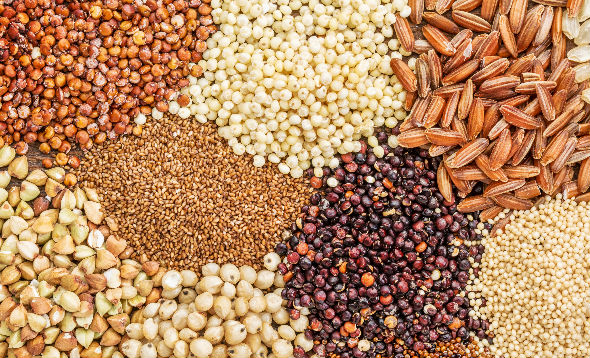That organic living is a conscious health choice
Gluten: Facts and Fiction
What is gluten? What does it do?
Gluten is a family of proteins found in grains. Rye and barley contain gluten as does wheat and its many variations like durum, farina, faro, kamut, spelt, and semolina. Gluten, however, is not found in all grains. Amaranth, buckwheat, corn, millet, quinoa, all forms of rice, and teff are gluten-free. Oats while naturally gluten-free, are often harvested, milled, and processed alongside wheat. So unless derived from designated gluten-free facilities, oat products may contain traces.
When combined with water, gluten-containing flours develop a sticky consistency. Interestingly, it’s for these adhesive, glue-like properties that glu-ten received its name. In baked goods, gluten binds ingredients and imparts elasticity, allowing dough to rise without losing its structure. In our mouths, it delivers the desirable pillow-like chewiness we appreciate in breads, cereals, biscuits, crackers, and pastries.
What is the problem?
From a culinary standpoint, gluten seems like a slam-dunk. Unfortunately, from a nutritional perspective, it’s kind of a mixed bag. A growing number of individuals experience adverse reactions after consumption. The symptoms of gluten intolerance can progress slowly or immediately, ranging from mild to severe, and arise gastro-intestinally or throughout the whole body.
Of all of the gluten-related disorders, Celiac or Coeliac Disease (CD) – a chronic autoimmune condition - is the most worrisome. When a person with CD consumes even small amounts of gluten, their immune system mounts an inflammatory attack on the lining of the small intestine. Symptoms may manifest digestively (gas, bloating, abdominal pain and diarrhea), non-digestively (headache, fatigue, joint pain) or not at all – which can complicate diagnosis. However if unidentified and untreated, the long-term malabsorption and tissue damage pose serious health implications. Some medications can help to reduce symptoms, but the only ‘cure’ is complete abstinence from all dietary gluten.
More prevalent than CD is non-celiac gluten-sensitivity (NCGS). Individuals with NCGS can experience any range or combination of the symptoms of CD, without the characteristic injury to the small intestine. However, the defining characteristic of NCGS is that symptoms resolve relatively quickly upon switching to a gluten-free regime.
What is the cause?
The incidence of all gluten-related disorders is on the rise worldwide. Experts aren’t exactly sure why. Some reason that gluten has always been troublesome but that scientists couldn’t pinpoint its involvement up until now. Others blame the increased global consumption of wheat, borne of the westernisation of diets – especially in the Middle East, Asia, and Africa – which led to wheat replacing rice and other staple grains.
The Americas and Europe also rely on wheat-based ingredients in processed foods more than ever before. With higher percentages of gluten, baked goods are less apt to crumble with slicing or lose their shape on market shelves. Others point to modern changes in wheat farming. Genetic modification for stronger wheat crops offers the benefits of accelerated growth, abundant harvests, and resistance to pests, disease, and climate shifts. Sadly, as wheat becomes faster, higher, and stronger – it also proves a challenge to digest.
What you should consider before going gluten-free
If you frequently suffer from digestive discomfort or irregular bowel pattern, visit first with a gastrointestinal specialist who can investigate and rule out any underlying GI disorders. Thereafter, go on a gluten-free diet trial and observe if symptoms subside. Likewise, children or adults who are newly diagnosed or managing conditions connected with gluten-sensitivity (multiple allergies, chronic inflammation, or autoimmune diseases) might consider this process as well.
A registered dietetics professional can offer informed guidance in grocery shopping, menu selections, and meal preparation to ensure your new regime is:
- truly free of all gluten - as it can hide in sauces, dressings, and processed foods
- nutritionally complete – not lacking in any of your daily requirements
- therapeutic – incorporating any superfoods, nutraceuticals or supplements known to promote healing or restore optimal digestion
Now what if you are healthy and without symptoms, should you go gluten-free? There are a few considerations to keep in mind before making the switch:
Remove and replace: The more varied and liberal our diet becomes, the greater our capacity to saturate our systems with the full scope of nutrition the food supply has to offer. With each restriction – singular foods or entire food groups – this becomes more challenging. Gluten-containing grains provide valuable minerals (iron, calcium, zinc, and magnesium), B vitamins, and fibers. Other gluten-free alternatives can make up the difference, but this adds another layer of attention to daily food choices.
Anticipate premium prices: Gluten-free eating often requires gluten-free home-cooking. While blogs, support groups, and website offer plenty of recipes, these usually entail extra time for sourcing ingredients and hands-on prep. Manufacturers recognise the welcome convenience of pre-made alternatives and pad their prices accordingly – sometimes charging up to two to three times that of the standard equivalent.
‘Gluten-free’ and ‘healthy’ – not necessarily the same:
Attracted to – or perhaps distracted by – a “gluten-free” label on the front packaging, consumers often overlook nutrition information and ingredients listed on the back and side panels. Many cereals, pastas, and breads use grains that are gluten-free, but are also highly refined and stripped of their valuable nutrients. Manufacturers also process products with preservatives, stabilisers, flavourings and other chemical agents to compensate for losses in texture or mouth-feel when gluten is removed. For non-intolerant individuals, prioritising “100% whole grain” products with no artificial additives might prove a better focus for overall health - weight maintenance, blood sugar stability, nutritional adequacy, and chemical-free eating.


























_1672804154.jpg)

_1611290459.jpg)